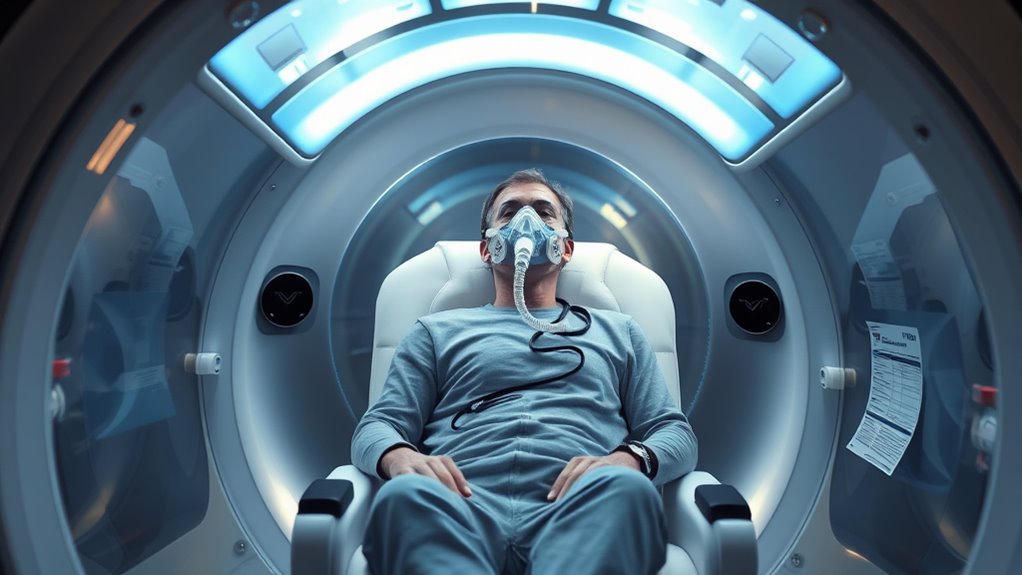Hyperbaric oxygen therapy boosts healing by exposing you to pure oxygen at higher pressure, increasing oxygen absorption in your blood and tissues. This process enhances tissue repair, fights infections, reduces inflammation, and promotes new blood vessel growth. While generally safe, some risks include ear barotrauma or oxygen toxicity. Ongoing research shows promising benefits for various conditions. To discover how this therapy could support your health, explore the detailed benefits, risks, and latest findings.
Key Takeaways
- HBOT enhances oxygen delivery to tissues, promoting healing and immune function, particularly in damaged or ischemic areas.
- Benefits include improved wound healing, infection control, and reduction of inflammation, supported by clinical research.
- Risks are generally low but can include ear barotrauma, oxygen toxicity, and claustrophobia in some cases.
- Ongoing research explores HBOT’s effectiveness for conditions like traumatic brain injury, stroke, and certain degenerative diseases.
- Proper medical supervision and regulation are essential to maximize benefits and minimize potential risks during therapy.

Have you ever wondered how breathing pure oxygen in a pressurized chamber can promote healing? When you step into a hyperbaric oxygen therapy (HBOT) chamber, you’re exposing your body to a higher-than-normal atmospheric pressure while inhaling 100% oxygen. This combination substantially boosts your oxygen absorption, which is vital for tissue repair and immune function. Under normal circumstances, your blood carries oxygen loosely bound to hemoglobin, but in HBOT, the increased pressure allows your lungs to absorb much more oxygen directly into your plasma. This process amplifies the amount of oxygen reaching your tissues, even those with compromised blood flow.
The pressure effects are fundamental to how HBOT works. When you breathe in pure oxygen at elevated pressures, your blood plasma becomes saturated with oxygen, creating a state where tissues can receive oxygen even in areas with poor circulation or damaged blood vessels. The pressure causes your lungs to absorb oxygen more efficiently, forcing a greater volume into your bloodstream. As a result, oxygen can diffuse deeper into tissues, promoting healing at cellular levels. This enhanced oxygen delivery supports processes like collagen synthesis, angiogenesis (new blood vessel formation), and fighting infections. The pressure effects also help reduce swelling and inflammation by constricting blood vessels in some cases, which minimizes tissue damage and pain.
Additionally, the hyperbaric environment can enhance the efficacy of certain treatments by creating an optimal setting for cellular repair and immune response. The therapy sessions are time-controlled, often lasting around 60 to 90 minutes, during which you breathe pure oxygen in a pressurized environment. The key is that the pressure is carefully regulated to optimize oxygen absorption without causing harm. This controlled environment allows your body to harness the full benefits of increased oxygen availability. It’s not just about breathing oxygen; it’s about how the pressure amplifies your body’s natural healing capabilities by maximizing the oxygen delivered at the cellular level.
Frequently Asked Questions
How Long Does Each Hyperbaric Oxygen Therapy Session Typically Last?
A typical hyperbaric oxygen therapy session lasts about 60 to 90 minutes, depending on your treatment plan. You’ll usually undergo multiple sessions per week, with treatment frequency varying based on your condition. During each session, you’ll sit or lie comfortably in a pressurized chamber while breathing pure oxygen. The duration and frequency are tailored to your specific needs, optimizing the therapy’s benefits and ensuring safe, effective treatment.
Are There Any Specific Age Restrictions for Hyperbaric Oxygen Therapy?
Imagine a spectrum of ages, from tiny infants to wise seniors—hyperbaric oxygen therapy has few strict age restrictions. Age considerations focus mainly on pediatric suitability, where careful assessment guarantees safety. While generally safe for most, your doctor evaluates individual health and developmental factors. So, whether you’re a child or an older adult, personalized evaluation helps determine if hyperbaric oxygen therapy fits your needs, ensuring comfort and safety at every stage of life.
Can Hyperbaric Oxygen Therapy Be Combined With Other Treatments Safely?
Yes, hyperbaric oxygen therapy can often be combined with other treatments safely, but you should always consult your healthcare provider first. They’ll assess combination safety and treatment integration to ensure no adverse interactions. Your provider considers your specific condition, medications, and overall health, so following their guidance minimizes risks. Properly coordinated treatment guarantees you get the most benefit without compromising safety during combination therapy.
What Are the Long-Term Effects of Repeated Hyperbaric Sessions?
Repeated hyperbaric sessions can lead to long-term effects like oxygen toxicity, which may cause lung or nerve damage over time. You might also experience ear barotrauma or sinus issues if sessions are frequent and not properly managed. While many people tolerate repeated treatments well, it’s essential to monitor your health closely. Consult your healthcare provider regularly to weigh the benefits against potential long-term risks of repeated hyperbaric oxygen therapy.
How Do I Know if I Am a Suitable Candidate for This Therapy?
You’re a suitable candidate for hyperbaric oxygen therapy if your medical history indicates conditions like non-healing wounds, radiation injury, or certain infections. Your healthcare provider assesses your treatment suitability by reviewing your medical history, current health status, and potential risks. They’ll also consider any contraindications, such as lung issues or pregnancy, to determine if this therapy benefits you without undue risk. Always consult your doctor for personalized advice.
Conclusion
As you explore hyperbaric oxygen therapy, remember it’s a double-edged sword—offering a lighthouse guiding you through healing’s fog, yet harboring risks like stormy seas. With research illuminating its potential and pitfalls, you stand at a crossroads, holding the map to your health’s voyage. Approach with cautious curiosity, trusting that with knowledge, you can navigate these depths safely and harness the therapy’s promise as a beacon of hope on your healing journey.









